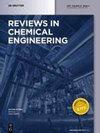DFT and hybrid classical–quantum machine learning integration for photocatalyst discovery and hydrogen production
IF 6.6
3区 工程技术
Q1 ENGINEERING, CHEMICAL
引用次数: 0
Abstract
Photocatalytic hydrogen production is a key pathway toward sustainable energy, driven by semiconductors that utilize sunlight for water splitting. This review highlights recent advances in material design, theoretical modeling, and data-driven discovery. Focus is given to visible-light-active semiconductors with optimal band gaps (1.8–2.4 eV), such as BiVO用于光催化剂发现和制氢的DFT和混合经典量子机器学习集成
光催化制氢是实现可持续能源的关键途径,由利用阳光分解水的半导体驱动。本综述重点介绍了材料设计、理论建模和数据驱动发现方面的最新进展。重点是具有最佳带隙(1.8-2.4 eV)的可见光活性半导体,如BiVO4, g-C3N4和CdS,它们能够实现高效的氧化还原反应。混合体系结构,包括pt负载TiO2和CdS/ZnS核壳体系,显示出超过105 mol m−2 s−1的析氢速率。基于稀土掺杂氟化物的上转换纳米材料将光捕获扩展到近红外,与量子点结合时提高了量子产量。工程异质结和碳基二维界面改善电荷分离和抑制复合。热力学参数,如低过电位(<0.3 V)和高吸收系数(>105 cm−1)与高催化效率相关。时间相关模拟和密度泛函理论(DFT)提供了对结构-性质关系的见解。此外,机器学习模型通过导航复杂的组成和结构空间来加速发现。在整合理论、实验和人工智能驱动方法的同时,本文提出了一个合理设计可扩展光催化剂的框架,以满足未来的能源需求。
本文章由计算机程序翻译,如有差异,请以英文原文为准。
求助全文
约1分钟内获得全文
求助全文
来源期刊

Reviews in Chemical Engineering
工程技术-工程:化工
CiteScore
12.30
自引率
0.00%
发文量
37
审稿时长
6 months
期刊介绍:
Reviews in Chemical Engineering publishes authoritative review articles on all aspects of the broad field of chemical engineering and applied chemistry. Its aim is to develop new insights and understanding and to promote interest and research activity in chemical engineering, as well as the application of new developments in these areas. The bimonthly journal publishes peer-reviewed articles by leading chemical engineers, applied scientists and mathematicians. The broad interest today in solutions through chemistry to some of the world’s most challenging problems ensures that Reviews in Chemical Engineering will play a significant role in the growth of the field as a whole.
 求助内容:
求助内容: 应助结果提醒方式:
应助结果提醒方式:


